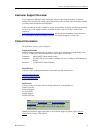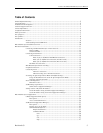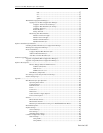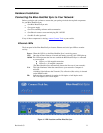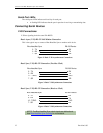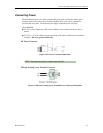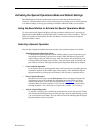
Connect Tech Blue Heat/Net Sync User Manual
10 Revision 0.03
Understanding Virtual COM Ports
In a typical serial port setup, the application communicates directly with the connected serial
port hardware.
Virtual COM ports differ in that the application communicates with a network protocol layer that
transfers the necessary information to and from the remote serial ports. The virtual ports appear
as standard serial ports to the application, but in reality the data is translated into a series of
Ethernet messages between the Blue Heat/Net Sync unit and the host computer. The serial port is
not physically connected to the host computer, but this is transparent to the application trying to
access it.
There are several advantages to using virtual COM ports, which include:
Distance – The serial ports can be a great distance away from the host computer. They are
not limited by the standard electrical characteristics of the RS-232 or RS-422 interface
because the primary data transfer is being done via Ethernet. Depending on the set up, these
serial ports can be at a different location and the Internet can act as the carrier of the serial
port traffic.
Speed – Short RS-232/422 cable lengths can be used with the primary distance relying on
the network connection. The capacitance of long lengths of serial cable does not limit data
speeds in these cases.
Cabling – Cost effective Ethernet cabling can be used for the transfer of information to the
Blue Heat/Net Sync and often this is part of the existing networking infrastructure.
Connecting serial ports in a remote location can be as easy as plugging in a Blue Heat/Net
Sync to the Ethernet network. This provides a simple, clean cabling arrangement.
Port Sharing – In some applications it is desirable to have a serial resource that is accessed
and shared by more than one host computer. Connect Tech‟s virtual serial port technology
allows this to be done easily.
Routing – Different ports on a Blue Heat/Net Sync can be connected to multiple host
computers.
Monitoring – Because the virtual serial ports are on the network, they can easily be
monitored to ensure everything is operating correctly.
Blue Heat/Net Sync Installation Overview
There are three main stages in the installation process for your Blue Heat/Net Sync.
1. Hardware Installation
This involves the physical connection of the Blue Heat/Net Sync hardware to your
network, and addresses issues such as cabling and power requirements.
2. Blue Heat/Net Sync Configuration
The first step in the configuration process is to set the IP Address. Then use one of three
available methods to configure the Blue Heat/Net Sync firmware settings for your
application. This can be done through the SCM (Serial Configuration Manager) or the
WCM (Web Configuration Manager), depending on circumstances and personal
preference.
3. Software Installation for Windows
This step installs and configures the Blue Heat/Net Sync drivers and ports for your host
Operating System and allows you to set parameters specific to your serial requirements.
This is done via the Blue Heat/Net Sync Configuration Manager.
NOTE: Software support for Windows and Linux is still in
development




